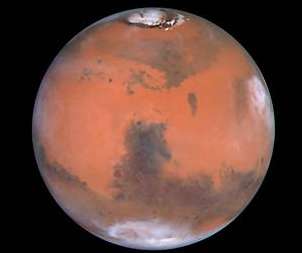Direct Imaging of
MARS
on its closest pass-by on
June 20, 2001
(about 42 million miles from Earth)
No telescope, only a hand-held Olympus Digital Camera
This is one of my best shots. I used the highest
resolution setting of the camera (SHQ).
I discovered an interesting thing. In this
highest resolution mode, the 2.1 megapixel format is used
in its entirety. However, the sky was black and
the only light recorded on the CCD was that
from Mars. Thus, even in this highest of resolution
mode, the digital image size came out only 34k! Why?
It appears as if the Olympus camera has a dynamic
pixel storage system and uses pixels only if they have information.
Since most of the background had no information, they were ignored. Interesting
discovery, yes?
Obviously Mars was really small in the original
image as shown below:
Then, I took this small 34k image, cropped it,
then resized the image to 300k and now you can
see Mars in all its glory!

This is Mars captured from Earth by the Hubble
Telescope
This is what happens if you move the camera during
an exposure! All images were hand-held. The exposure
was set on "automatic" and it took about 1/2
second. I had the optical zoom to its maximum of 3.1.
I think this shows the very extreme power of the Olympus Digital Camera System. One only has to try some outlandish things in order to fully exploit the potential of this beautiful camera.
Click HERE
for MSNBC News Story on the
Close Encounter with Mars
Here is another interesting aspect
in comparing the
surface of Mars with the surface
of Earth
Click HERE